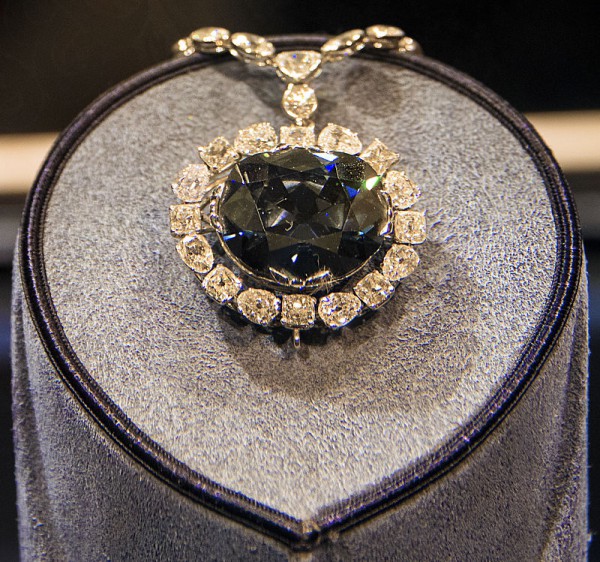
Hope Diamond in the United States National Museum of Natural History
On September 11, 1792, while Louis XVI and his family were imprisoned in the Temple in the early stages of the Reign of Terror during the French Revolution, a group of thieves broke into the Royal Storehouse, the Hôtel du Garde-Meuble de la Couronne, and stole most of the Crown Jewels during a five-day looting spree. Among those was also the Blue Diamond of the Crown of France, later English-speaking historians have simply called it the French Blue, a 67.125-carat (13.4250 g) stone, which was recut into the Hope Diamond, one of the most famous jewels in the world.
Jean-Baptiste Tavernier and the Tavernier Blue
The story of the Hope diamond dates back even further. Buried deep within the Earth its origin dates back approximately 1.1 billion years. Several accounts, based on remarks written by the gem’s first known owner, French gem merchant Jean-Baptiste Tavernier, suggest that the gemstone originated in India, in the Kollur mine in the Guntur district of Andhra Pradesh in the seventeenth century. It is unclear, how Tavernier got into possession of the gem, whether by theft or by purchase. However, he brought to Paris a large uncut stone, which became known as the Tavernier Blue diamond. It was a crudely cut triangular shaped stone of 115 carats (23.0 g). Tavernier’s book, the Six Voyages (French: Les Six Voyages de J. B. Tavernier), contains sketches of several large diamonds that he sold to Louis XIV in possibly 1668 or 1669, among them the Tavernier Blue. Tavernier sold this large blue diamond along with approximately one thousand other diamonds to King Louis XIV of France for 220,000 livres, the equivalent of 147 kilograms of pure gold.
The Crown of France
In 1678, Louis XIV commissioned the court jeweller, Sieur Pitau, to recut the Tavernier Blue, resulting in a 67.125-carat (13.4250 g) stone which royal inventories thereafter listed as the Blue Diamond of the Crown of France. According to one report, Louis ordered Pitau to “make him a piece to remember“, and Pitau took two years on the piece, resulting in a “triangular-shaped 69-carat gem the size of a pigeon’s egg that took the breath away as it snared the light, reflecting it back in bluish-grey rays.” In 1749, Louis XIV’s great-grandson, King Louis XV, had the French Blue set into a more elaborate jewelled pendant for the Order of the Golden Fleece by court jeweler André Jacquemin. The piece fell into disuse after the death of Louis XV. The diamond became the property of his grandson King Louis XVI.
The Reign of Terror
On September 11, 1792, while Louis XVI and his family were imprisoned in the Temple in the early stages of the Reign of Terror during the French Revolution, a group of thieves broke into the Royal Storehouse, the Hôtel du Garde-Meuble de la Couronne, and stole most of the Crown Jewels during a five-day looting spree.[12] While many jewels were later recovered, including other pieces of the Order of the Golden Fleece, the French Blue was not among them and it disappeared from history. On 21 January 1793, Louis XVI was guillotined and Marie Antoinette was guillotined on 16 October of the same year: these beheadings are commonly cited as a result of the diamond’s “curse”. A likely scenario is that the French Blue, sometimes also known as the Blue Diamond,[12] was “swiftly smuggled to London” after being seized in 1792 in Paris. It had long been believed that the Hope Diamond had been cut from the French Blue until confirmation finally happened when a three-dimensional leaden model of the latter was rediscovered in the archives of the National Museum of Natural History in Paris in 2005.
Thomas Hope and the Hope Diamond
A blue diamond with the same shape, size, and color as the Hope Diamond was recorded by John Francillon in the possession of the London diamond merchant Daniel Eliason in September 1812, the earliest point when the history of the Hope Diamond can be definitively fixed. The stone was later reported to have been acquired by a rich London banker named Thomas Hope, for either $65,000 or $90,000. In 1839, the Hope Diamond appeared in a published catalog of the gem collection of Henry Philip Hope, who was a member of the same Anglo-Dutch banking family. After falling into the ownership of the Hope family, the stone came to be known as the “Hope Diamond”. After the death of Henry Philip Hope in 1839, the oldest nephew, Henry Thomas Hope, received eight of the most valuable gems, including the Hope Diamond. It was displayed in the Great Exhibition of London in 1851 and at the 1855 Exposition Universelle in Paris, but was usually kept in a bank vault.
Specimen #217868
In 1902, the Hope diamond was sold into the United States and went through many hands. In 1958, Smithsonian mineralogist George Switzer is credited with persuading jeweler Harry Winston to donate the Hope Diamond for a proposed national gem collection to be housed at the National Museum of Natural History, where it became Specimen #217868. It’s worth, if sold in 2011, was given with $200–$250 million.
Mineralogy: Lecture 27, Diamond, [6]
References and Further Reading:
- [1] The Hope Diamond, at Encyclopedia Smithsonian
- [2] The Hope Diamond, at Britannica Online
- [3] The Affair of the Diamond Necklace, SciHi Blog
- [4] Video of Hope Diamond via The Guardian
- [5] The Hope Diamond at Wikidata
- [6] Mineralogy: Lecture 27, Diamond, Kenneth Befus @ youtube
- [7] Brickell, Francesca Cartier. “The Secret History Of The Hope Diamond: How Pierre Cartier Sold A Cursed Jewel”. Forbes.
- [8] Wise, Richard W. (2010). “Historical Time Line, The French Blue / Part III”. The French Blue.
- [9] Image grid of individual diamonds, via Wikidata and DBpedia





